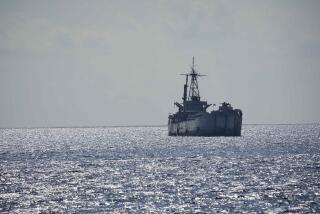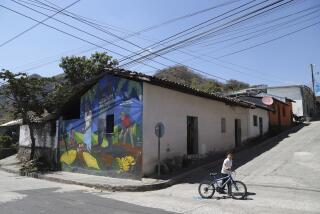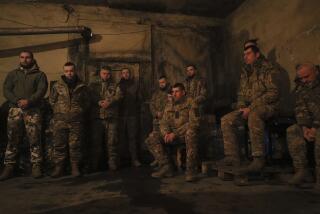‘Neglected’ Forces’ Morale Sags : Philippine Troops Short of Weapons--and Medals
TAGBILARAN, Philippines — Constable Adriano Bacus and 25 other men who had shown “exemplary bravery in the face of combat” stood at attention here, waiting to receive the Military Service Medal. What they did not know was that they would not be allowed to keep it.
In a bizarre ceremony Wednesday, a bitter commentary on the state of the Philippine Armed Forces, one general pinned the medals on the men’s chests and, seconds later, another general took them off. The generals had just two medals for the ceremony.
“I am very sorry that today we had to take back the medals that we gave you,” Brig. Gen. Edgardo Abenina, commander of police operations in the central Philippines, told the men in a somber speech moments later.
Bacus had risked his life for his country, taking a .45-caliber bullet in his side while fighting a band of Communist rebels trying to secure a foothold in this provincial capital more than 400 miles south of Manila. The others, some policemen, some soldiers, had performed similar deeds.
Abenina, angry as well as apologetic, said: “We are not taking back these awards. It is just that we do not have enough medals to give, because we do not have money to buy the medals. That is how neglected we are in the armed forces today. Not even the morale and the spirit of the soldiers is being looked after. I just don’t know how to tell you how I feel every time I have to stand before you like this.”
It was a wrenching vignette, and it served to point up the sagging morale, the lack of equipment and the resulting inefficiency in combat that affect President Corazon Aquino’s 155,000 soldiers and policemen as they try to deal with the Communist insurgency.
According to senior officers such as Abenina, the awards ceremony here on Bohol Island helps explain why the soldiers and policemen are restive and alienated and in some cases rebellious a year and a half after the 1986 uprising that toppled President Ferdinand E. Marcos and put Aquino in his place.
The officers who led the uprising, among them Abenina and most of the present general staff, say that Marcos, who ruled for 20 years, turned the military into a private army. They say that only by overthrowing him could efficiency, morale and honor be restored.
But in visits to military outposts in war-affected zones throughout the Philippines, a reporter found that morale and efficiency appeared to be lower than in Marcos’ final years. Front-line captains and majors complained of having to use their personal shotguns and revolvers in combat because military headquarters in Manila had failed to send them enough rifles.
Lack Helicopter Support
They said troops pinned down by rebels had been denied helicopter support, essential in counterinsurgency, because there are not enough helicopters and because of inadequate maintenance. In a recent incident in the central Philippines, more than 100 rebels escaped with dozens of government weapons after killing 20 soldiers because the guns on two helicopter gunships jammed and rockets failed to explode.
On the troubled island of Negros, where insurgency and a long tradition of unequal distribution of wealth have persuaded analysts to forecast all-out civil war, an officer noted bitterly that his men are allowed only 30 rounds of ammunition apiece when they go into combat because supplies are low.
“Right now,” said Capt. Leocadio Santiago, who took part in the 1986 rebellion against Marcos, “we have an army that is not doing its job because it cannot do its job.”
Gen. Fidel V. Ramos, the armed forces chief of staff, has used such horror stories to support his request for a 41% increase in the military budget for 1988.
Military Spending Low
In presenting his case to the Philippines’ new Congress, Ramos has briefed the lawmakers in detail, emphasizing that the Philippine government spends only $2,653 per soldier per year--the lowest level in all Southeast Asia. The Philippine military gets 1.6% of the national budget, a fourth of what it received in 1976, even though the Communist New People’s Army has grown to more than 23,000 fighting men.
The increased budget is needed, Ramos said in his request, “for the manufacture and acquisition of additional firepower and equipment to replace aged, obsolete, unserviceable and unrepairable items.”
The U.S. Congress recently approved a Reagan Administration request for $100 million in military aid to the Philippines, restoring $50 million it had eliminated. The funds were restored after the Pentagon explained the plight of the Philippine military.
In appealing for the additional aid, Assistant Defense Secretary Richard L. Armitage described the Philippine counterinsurgency effort as ineffective. He said the Philippines has only about half of the trucks, helicopters, ships and communications equipment it needs.
These abstract statistics take on a frightening dimension here on Bohol, a remote province of 72 islands and more than 800,000 people where four years ago there were no signs of the Communist insurgency.
Bohol Once Quiet
For years, military authorities said, Bohol was a place of rest and recuperation for the guerrillas, who have been fighting for nearly 18 years on the islands of Cebu, to the north, and Mindanao, to the south.
But in 1983 a rebel leader known to the military as Commander Vargas formed the first major fighting unit on Bohol and began ambushing military units. The intensity of the attacks has increased steadily ever since, and this year there have been several big fire fights, including the one in July in which Constable Bacus was wounded.
“The rebels were trying to establish a foothold in the town of Cortes so they could hit targets in the provincial capital of Tagbilaran,” Police Lt. Augusto Marquez, the province’s chief intelligence officer, told a reporter. “We managed to nip it in the bud, but we are very afraid there will be a next time.
“Our big problem here in the city right now is trying to find out how we are going to stop the rebels from hitting us, now that they have footholds elsewhere in the province.”
Marquez said he thinks the guerrillas have been landing on the island almost at will, by boat from Cebu and Mindanao. He said the military is powerless to stop them.
One Boat for Long Coast
The Philippine Coast Guard has three tiny stations along the 320 miles of coastline on Bohol’s main island. But it has just one boat to patrol the coast, a native outrigger with a 16-horsepower engine. There are no helicopter gunships based on Bohol, and when regional headquarters was asked for one during a recent fire fight, it was told that none was available.
Military patrols must pass through areas known to be occupied by rebels, yet they have no armored vehicles because none has been deployed on the island. Overall, the military on Bohol is described officially as “undermanned.” This is the assessment contained in a recent report to Abenina, the regional commander.
Abenina, who says he has placed principles above personal loyalties since the 1986 mutiny against Marcos, said that the problems of Bohol and many islands like it are not caused simply by the lack of military resources brought on by the Philippines’ general poverty. He also blames what he regards as an anti-military bias in the priorities of the Aquino government.
In his speech to the military heroes Wednesday, Abenina’s voice cracked when he criticized a government program to spend 5 billion pesos ($250 million) to rehabilitate members of the Communist New People’s Army if they will put down their arms and return to civilian life.
“The government has programmed billions of pesos to rehabilitate a New People’s Army rebel who has killed soldiers and policemen, who has extorted taxes from our civilians, who has orphaned and widowed thousands of others,” Abenina said.
Decries Neglect
“And what has the government done for the widows, the children and the parents of members of our command who have died or been maimed in combat? I have come across widows and mothers of soldiers who died in combat who have become prostitutes and who have been totally neglected, and yet the government has programmed billions of pesos for the rebels who killed those soldiers.
“And you well know that there is only one hospital to treat the wounded soldiers in this entire region, and that that hospital has no medicines.”
Such speeches have earned Abenina sharp criticism from local government officials, and from members of the Aquino administration. Although Aquino has personally supported Abenina, promoting him from colonel to general last year and publicly endorsing his performance, there have been many attempts by local officials appointed by Aquino to get the general transferred or dismissed from the service.
Tells of Censure
In his speech Wednesday, Abenina told his men how he had been dressed down by the armed forces vice chief of staff, Renato De Villa, because of his anti-government speeches.
“But I have to lay my head on the chopping block and wait for that ax to sever my head from my body, because it is the only way that you men will believe me,” Abenina said. “I cannot offer you medals, because I have none to offer. I can, however, offer you my life.”
For men like Lt. Marquez, a professional soldier who graduated from the Philippine Military Academy three years ago, such deficiencies are puzzling.
“You know, at the academy we were taught all your sophisticated American counterinsurgency techniques,” he told a reporter. “But when you don’t even have enough rifles and bullets, let alone medals for soldiers who have learned to do without the basic tools of war, what good is all this training, anyway?”
More to Read
Sign up for Essential California
The most important California stories and recommendations in your inbox every morning.
You may occasionally receive promotional content from the Los Angeles Times.










